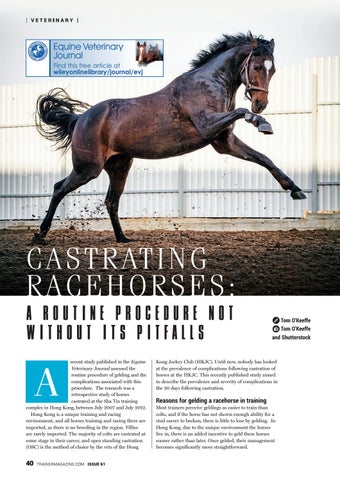| VETERINARY |
C A S T R ATING RACEHOR SES: A ROUTINE PROCEDURE NOT WITHOUT ITS PITFALLS
A
recent study published in the Equine Veterinary Journal assessed the routine procedure of gelding and the complications associated with this procedure. The research was a retrospective study of horses castrated at the Sha Tin training complex in Hong Kong, between July 2007 and July 2012. Hong Kong is a unique training and racing environment, and all horses training and racing there are imported, as there is no breeding in the region. Fillies are rarely imported. The majority of colts are castrated at some stage in their career, and open standing castration (OSC) is the method of choice by the vets of the Hong
40
TRAINERMAGAZINE.COM ISSUE 61
Tom O’Keeffe Tom O’Keeffe and Shutterstock
Kong Jockey Club (HKJC). Until now, nobody has looked at the prevalence of complications following castration of horses at the HKJC. This recently published study aimed to describe the prevalence and severity of complications in the 30 days following castration.
Reasons for gelding a racehorse in training
Most trainers perceive geldings as easier to train than colts, and if the horse has not shown enough ability for a stud career to beckon, there is little to lose by gelding. In Hong Kong, due to the unique environment the horses live in, there is an added incentive to geld these horses sooner rather than later. Once gelded, their management becomes significantly more straightforward.
